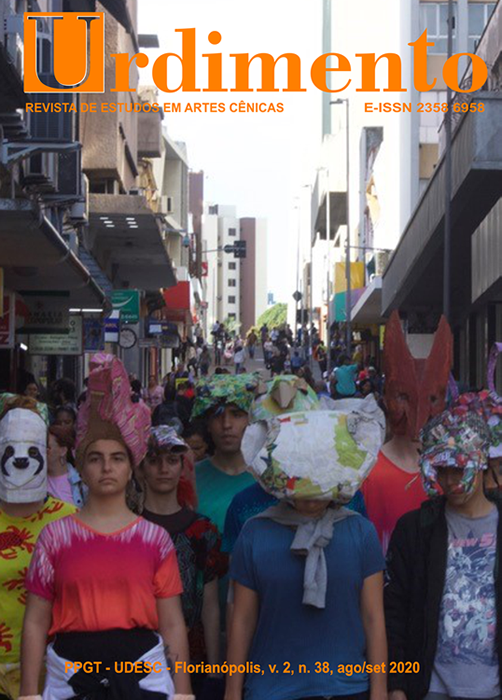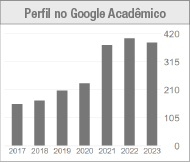Spatial-temporal figure-ground relations. Finite spaces in contemporary theatre and performance
DOI:
https://doi.org/10.5965/14145731023820200046Keywords:
Stage as dispositive, Relational spatial configurations, Spatial mediationAbstract
Taking a critique of mere architectural conceptions of theatrical spaces as its starting point, this paper discusses different ways of undermining the proscenium stage as what can be called a dispositif or apparatus of perception. It discusses up to which point the perturbation, negation and disaffirmation of the italian stage, carried out through different spatial conception by the performances analysed in this paper, can serve to exemplify Agamben’s afirmation that the profanation of a (political) dispositif highlights the point of ungovernability that exists at the beginning and the end of any political praxis.
Downloads
References
AGAMBEN, Giorgio ”O que é um dispositivo?” In: AGAMBEN, Giorgio. O que é o contemporâneo e outros ensaios. Chapecó: Argos, 2009.
BENJAMIN, Walter. ”O que é o teatro épico?” In: BENJAMIN, Walter. Obras Escolhidas, vol. 1. (Magia e técnica, arte e politica), São Paulo: Editora Brasiliense, 1985. p. 89.
BRANDSTETTER, Gabriele/WIENS, Birgit (Hg.), Theater ohne Fluchtpunkt. Das Erbe Adolphe Appias: Szenographie und Choreographie im zeitgenössischen Theater, Berlin, 2010, S. 9.
DERRIDA, Jacques. “A Diferença”, In: DERRIDA, Jacques. Margens da Filosofia. Campinas: Papirus, 1991.
DÜNNE, Jörg/GÜNZEL, Stephan. Raumtheorie. Grundlagentexte aus Philosophie und Kulturwissenschaften, Frankfurt/M.: Suhrkamp, 2006.
GÜNZEL, Stephan (ed.), Topologie. Zur Raumbeschreibung in den Kultur- und Medienwissenschaften, Bielefeld: Transcript, 2007.
GÜNZEL, Stephan. (ed.) Raumwissenschaften. Frankfurt/M.: Suhrkamp, 2009.
HAMACHER, Werner. “Amphora“, In: SCHWEEGER, Elisabeth (ed.) Wanda Golonka – Tanz Ensemble Modell. Berlin: Theater der Zeit, 2010; p. 29-34.
HAß, Ulrike. Das Drama des Sehens. Auge, Blick und Bühnenform, München: Fink, 2005.
LACOUE-LABARTHE, Philippe. Die Fiktion des Politischen. Heidegger, die Kunst und die Politik. Stuttgart: Edition Patricia Schwarz, 1990.
LIBESKIND, Daniel. “Das Ende vom Raum – ein Gespräch mit Gerhard Ahrens“, in: Hamburger Hefte, Nr. 4, raumgestalten, Hamburg, 2001, p. 42-51.
MÜLLER, Heiner. “Robert Wilson/Freunde“, in: MÜLLER, HEINER. Krieg ohne Schlacht, Köln: Kiepenheuer & Witsch, 1992, p. 327-336.
MÜLLER, Heiner Philoktet. in: MÜLLER, Heiner. Mauser, Berlin: Rotbuch, 1988, p. 7-42.
MÜLLER-SCHÖLL, Nikolaus. Das Theater des konstruktiven Defaitismus. Frankfurt/Basel: Stroemfeld, 2002.
MÜNZ, Rudolf. Theatralität und Theater. Zur Historiographie von Theatralitätsgefügen, Berlin, Schwarzkopf & Schwarzkopf. 1998, S. 82-103.
SOJA, Edward. Postmodern Geographies. The Reassertion of Space in Critical Social Theory. London & New York: Routledge, 1989.
STEINWEG, Reiner Brechts Modell der Lehrstücke. Zeugnisse, Diskussionen, Erfahrungen, Frankfurt/M., 1976
WALDENFELS, Bernhard. „Topographie der Lebenswelt“, in: GÜNZEL (ed.), Topologie. Zur Raumbeschreibung in den Kultur- und Medienwissenschaften, Bielefeld: Transcript, 2007, p.69 – 84.
WEIGEL, Sigrid. „Zum ‚topographical turn‘ – Kartographie, Topographie und Raumkonzepte in den Kulturwissenschaften“, in: KulturPoetik 2, 2 (2002), p. 151-165.
WILSON, Bob. “Die Architektur des theatralischen Raumes“. Entrevista com Tom Stromberg. In: Theaterschrift 2. The Written Space 1992, p. 102-107.
Downloads
Published
How to Cite
Issue
Section
License
Copyright (c) 2020 Urdimento - Revista de Estudos em Artes Cênicas

This work is licensed under a Creative Commons Attribution 4.0 International License.
Copyright Statement
The articles published by the magazine are free to use. The copyright is all assigned to the magazine. The articles whose authors are identified represent the expression from the point of view of their authors and not the official position of the journal Urdimento. The author (s) undertakes whenever publishing material relating to the article published in Revista Urdimento mention the said publication as follows: This article was originally published by Urdimento magazine in its volume (put the volume), number (put the number) in the year of (put the year) and can be accessed at:
http://www.revistas.udesc.br/index.php/urdimento
This work is licensed under a Creative Commons Attribution 4.0 International License.




